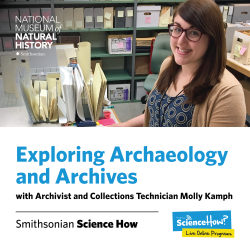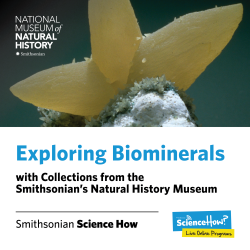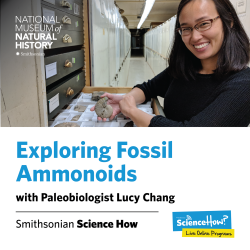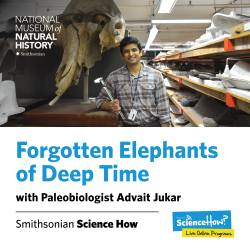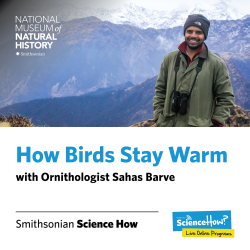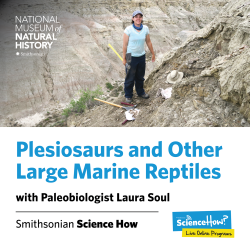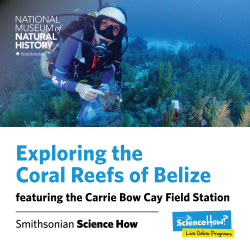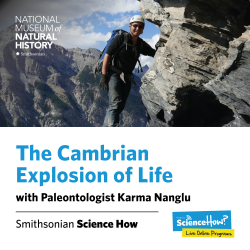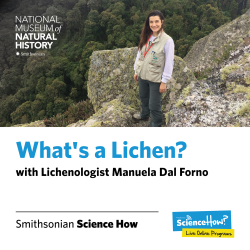Maggy Benson
Distance Learning Manager
Smithsonian's National Museum of Natural History
Science, Social Studies, Career and Tech Ed
:
Distance Learning Manager at the Smithsonian's National Museum of Natural History and producer of Smithsonian Science How, a live, TV-style show that connects Smithsonian scientists to students through the web, taking their questions and exploring science and research in a fun and informative way.
Maggy Benson's collections
Exploring Archaeology and Archives with Molly Kamph
<p>This collection features resources to supplement the <a href="https://naturalhistory.si.edu/education/teaching-resources/social-studies/unlocking-hidden-worlds-through-archaeology-and">Smithsonian Science How webcast video, Unlocking Hidden Worlds through Archaeology and Archives</a>. In the video, Project Archivist and Archaeological Collections Technician Molly Kamph. Molly introduces students to the collection of the famed archaeologist couple Rose and Ralph Solecki, whose Neanderthal discoveries and contributions to archaeology continue to be studied by scientists all over the world. Sharing unique objects and artifacts from archaeological dig sites (such as Shanidar Cave) where Neanderthal and early human settlements were discovered, Molly helps students understand how museum and archival work unlocks hidden worlds and untold stories.</p>
 Maggy Benson
Maggy Benson
26
Exploring Biominerals with Collections from the Smithsonian's Natural History Museum
<p>This is a collection created to explore biological minerals, also called biominerals. Biominerals are formed by living organisms by a process called "biomineralization." Humans create minerals: We build our bones with a mineral called apatite. Mollusks create minerals, too: their shells! Corals create mineral skeletons, which are built up over time to create the marine architecture we call a coral reef. Corals are composed of small polyps, which build up their hard skeletons out of a mineral called aragonite, which is also called calcium carbonate. Even some species of algae create a mineral called barite, which is present in their tissue. Bones, shells, and teeth are common examples of biominerals. </p>
<p>This collection contains two types of minerals: 1) naturally occurring minerals, minerals created by the Earth's natural processes and 2) biominerals, minerals created by living organisms.
</p>
<p>ACTIVITIES to do with this collection:
</p>
<p>1. Download the Student Worksheet and use this collection to complete it.
</p>
<p>2. Find the inorganic and biomineral versions of each of the following minerals. Once you have found them, download the "See Think Wonder" worksheet in this collection and fill it out, while comparing the two minerals.
</p>
<p>- Aragonite and calcite (look for mollusks, corals, echinoderms)
</p>
<p>- Apatite (look for bones, teeth)
</p>
<p>- Barite (look for algae)
</p>
<p>- Silica (look for diatoms, sponges, grasses)
</p>
<p>
</p>
<p>3. Learn a little more about each object by clicking on it, then clicking on the "info" button. Where was it found? When was it found? What do you notice about it? What do you wonder about it?
</p><p></p>
<p><br /></p>
 Maggy Benson
Maggy Benson
25
Exploring Fossil Ammonoids
<p>This collection can be used as a pre- and post-resource to support the free <a href="https://naturalhistory.si.edu/education/teaching-resources/paleontology/fossil-ammonites" target="_blank">Smithsonian Science How webcast video, Exploring Fossil Ammonoids with Paleobiologist Lucy Chang</a>. During the 30-minute video, your students will have an opportunity to interact through polls. <br><br></p>
<p>This collection contains objects from the Smithsonian’s National Museum of Natural History. Many of the specimens in this collection are fossil ammonoids, but other mollusks are included for comparison. Also included in the collection is a companion worksheet for students (with teacher key) to express their newly gained knowledge about ammonoids. <br><br></p>
<p>Ammonoids are an extinct group of marine mollusks that belong to the subclass Ammnoidea and the class Cephalopoda. A popular and well-known subgroup of ammonoids are ammonites. The closest living relatives of ammonoids are also cephalopods like squids, octopods, and cuttlefish, while the modern nautilus is more distantly related. </p>
<p>Ammonoids had shells made of calcium carbonate just like today’s snails, clams, oysters, and other shelled mollusks. Ammonoid shells varied in shape and size. Some ammonoids had tightly coiled shells (planispiral), while others had uncoiled, irregularly shaped shells (heteromorphs). Regardless of shape or size, the shell provided the ammonoid with protection and possibly camouflage. </p>
<p><br>Ammonoid shells had interior walls (septa) that created chambers inside of the shell. These chambers were connected by a narrow tube structure called a siphuncle. The ammonoid could use the siphuncle to control the amount of gas and fluid in each chamber, giving it the ability to achieve neutral buoyancy and move about in the marine environment. </p>
<p><br>Although ammonoid shells are abundant in the fossil record, there is an extremely poor record of their soft parts being preserved or fossilized. Based off of their relationships to mollusks alive today, ammonoids likely had bodies that were soft. The animal would have lived exclusively in the last chamber of its shell with numerous arms extending in a ring around its mouth, eating plankton and detritus, dead or decaying matter. Scientists study the shapes and patterns of ammonoid shells and related species, fossil and modern, to learn about the extinct animal. </p>
<p><br>Ammonoids lived around the globe and were present on earth for a very long time, about 350 million years. The entire group went extinct at the end of the Cretaceous, about 66 million years ago, along with the dinosaurs. </p>
<p><br>The abundance of ammonoids in the fossil record and their long history on earth make them good fossils to study. Geologists use ammonoid fossils as guide or index fossils, helping to date the rock layers from which the fossils were found. Paleobiologists can use fossil ammonoids to learn about patterns of extinction and glean information about the group's evolutionary history.</p>
 Maggy Benson
Maggy Benson
29
Smithsonian Science How: Exploring the Coral Reefs of Belize
<p><strong>Teachers: </strong>Use this collection of resources to supplement the video of the Smithsonian Science How webcast program, <em>Tracking the Health of Coral Reefs: Live from Belize. <strong></strong></em>The webcast was recorded October 8, 2019. To watch the video and get more information, visit: <a href="https://naturalhistory.si.edu/education/teaching-resources/life-science/tracking-health-coral-reefs-live-belize">https://naturalhistory.si.edu/education/teaching-resources/life-science/tracking-health-coral-reefs-live-belize</a></p>
<p><br></p>
<p><strong>How to use this collection: </strong>Use this collection of resources to learn more about the scientists being featured in the live broadcasts, about the Carrie Bow Cay Field Station in Belize, and to access resources about coral reef habitats and health. Download and print the pre- and post-webcast worksheet, or paste the questions into your own Google Classroom assignment (word doc). </p>
<p><br></p>
<p><strong>Start a conversation: </strong>We suggest using these resources to start a conversation with your students about who does science and how they do it. You can extend their understanding of how real science happens in the field by participating in our live webcasts on Oct. 8, 2019. Here are some questions to help facilitate a conversation with your students:</p>
<p></p>
<ul><li>Before reviewing resources: <em>What do you think marine scientists study? Can you think of an example of a marine habitat? How do you think scientists study marine habitats? What kind of tools do you think they can use to study underwater habitats? </em></li><li>After reviewing resources: <em>Do you have new ideas about what a marine scientist is? What are they? What is something you might have in common a marine scientist? What kind of tools do these marine scientists use for their research? What marine habitat are they studying? What's one way you can observe the world around you, like a scientist?</em></li></ul>
<p><br><strong></strong><br></p>
<p><strong>About the Carrie Bow Cay Field Station, Belize, Central America</strong><br></p>
<p>The Smithsonian Institution has a field station in Belize, which is located on a small island called Carrie Bow Cay. To get there, scientists must take a 15-mile boat ride from the town of Dangriga, Belize. Researchers from all over the world have been conducting research from this tiny field station for the 50 years that Smithsonian has been operating the station.</p>
<p>The Smithsonian’s Carrie Bow Cay Marine Field Station supports research projects of marine scientists year-round. It offers ready access to a variety of habitats, including thousands of small mangrove islands, countless patch coral reefs, vast seagrass meadows, underwater caves, three off-shore atolls, and the Belize mainland. </p>
<p>Carrie Bow Cay is located 14 miles offshore, located on the barrier reef off the coast of Belize and within the Mesoamerican Barrier Reef, which contains the largest barrier reef if in the Western Hemisphere and second largest in the world, second only to the Great Barrier Reef in Australia.</p>
<p>This reef system contains many different kinds of coral, which provide homes and food to hundreds of fish species, turtles and countless invertebrates, which are animals without backbones, like snails, squid, sea anemones, sea stars and urchins, and crustaceans like crabs and shrimp.</p>
<p>Coral reefs are important habitats for not just the plants and animals that live there, but for the health of the entire ocean. As our ocean changes, so are coral reefs. </p>
<p>Scientists use the Carrie Bow Cay marine station to study and monitor these changes. MarineGEO, a global partnership program operated by the Smithsonian Institution, sends scientists to the Carrie Bow Cay marine station every year to monitor these reef systems, along with the other nearby habitats like mangroves and sea grass beds. </p>
<p><br></p>
 Maggy Benson
Maggy Benson
16
What's a Lichen? How a Smithsonian Scientist Studies a Unique Symbiosis
<p>This collection supports the <a href="https://naturalhistory.si.edu/education/teaching-resources/life-science/exploring-amazing-world-lichens-manuela-dal-forno">Smithsonian Science How webcast video, "Exploring the Amazing World of Lichens with Manuela Dal Forno</a>."<br><br>Lichens are a symbiotic relationship between algae and fungus. They have been on earth for millions of years, living on rocks, trees, and soil in all different habitats on all seven continents. Even though lichens are all around us, scientists are still learning about what they are, where they live, and how many different species of lichens there are.</p>
<p><a href="https://naturalhistory.si.edu/education/distance-learning/what-is-lichen-symbiosis" target="_blank"></a></p>
<p>Fungus is any group of spore-producing organisms feeding on organic matter, and include molds, yeast, mushrooms, and toadstools. Algae is a simple, non-flowering plant. Algae contain chlorophyll and produce sugar through photosynthesis, like other plants, but do not have true stems, roots, leaves, or vascular tissue like most other plants. Lichenization is a fungal lifestyle, and therefore the name of lichen is the name of the fungus component.</p>
<p><a href="https://naturalhistory.si.edu/education/distance-learning/what-is-lichen-symbiosis" target="_blank"></a></p>
<p>When you look at a lichen, what you’re looking at is the “house” that the fungus and algae grow together. Scientists call this house a “thallus.” When algae and fungus come together to form this house, we see a lichen. This partnership is called a symbiotic relationship, because it helps both the fungus and algae survive. Research has shown that lichens are not a natural biological group, meaning they do not all come from a single common ancestor, in other words, lichens have many origins. Currently there are almost 20,000 species of lichenized fungi known.</p>
<p><a href="https://naturalhistory.si.edu/education/distance-learning/what-is-lichen-symbiosis" target="_blank"></a></p>
<p>In this symbiotic relationship, the fungus and algae benefit from being associated with each other. The fungus provides the house, its shelter (the thallus). This shelter helps the algae survive in habitats where it would otherwise be exposed to the elements and possibly could not survive. The algae provide food for the fungus, in the form of sugar. The sugar is a byproduct of photosynthesis that occurs within the algae.</p>
<p><a href="https://naturalhistory.si.edu/education/distance-learning/what-is-lichen-symbiosis" target="_blank"></a></p>
<p>Lichens are very important for the environment. They are an important food source for many animals, provide nest materials for birds, and provide habitat and material for biomimicry for insects and other organisms.</p>
<p><a href="https://naturalhistory.si.edu/education/distance-learning/what-is-lichen-symbiosis" target="_blank"></a></p>
<p>Lichens are also important for humans by providing natural dyes, perfumes, litmus paper, and even food. Humans even use lichens as bio-indicators, organisms that help humans monitor the health of the environment. Some species of lichens are sensitive to environmental pollution, so their presence or absence can help us understand more about the health of the environment, like air quality. </p>
<p><a href="https://naturalhistory.si.edu/education/distance-learning/what-is-lichen-symbiosis" target="_blank"></a></p>
<p>Lichens produce over one thousand different chemical compounds, most of them unique to lichens. These compounds include acids and pigments. Some chemicals may even fluoresce under UV light, making them important components for lichen identification.</p>
<p><a href="https://naturalhistory.si.edu/education/distance-learning/what-is-lichen-symbiosis" target="_blank"></a></p>
<p>Lichens have DNA, which is used to identify lichen and compare relationships amongst and within species. DNA analysis has been an important tool for lichenologists in identifying and understanding the biodiversity of lichens.</p>
<p><a href="https://naturalhistory.si.edu/education/distance-learning/what-is-lichen-symbiosis" target="_blank"></a><a href="https://naturalhistory.si.edu/education/distance-learning/what-is-lichen-symbiosis" target="_blank"><br></a></p>
<p><a href="https://naturalhistory.si.edu/education/distance-learning/what-is-lichen-symbiosis" target="_blank"></a></p>
<p><a href="https://naturalhistory.si.edu/education/distance-learning/what-is-lichen-symbiosis" target="_blank"></a></p>
<p><a href="https://naturalhistory.si.edu/education/distance-learning/what-is-lichen-symbiosis" target="_blank"></a></p>
<p><a href="https://naturalhistory.si.edu/education/distance-learning/what-is-lichen-symbiosis" target="_blank"></a></p>
<p><a href="https://naturalhistory.si.edu/education/distance-learning/what-is-lichen-symbiosis" target="_blank"></a></p>
<p><a href="https://naturalhistory.si.edu/education/distance-learning/what-is-lichen-symbiosis" target="_blank"></a></p>
<p><a href="https://naturalhistory.si.edu/education/distance-learning/what-is-lichen-symbiosis" target="_blank"></a></p>
<p><a href="https://naturalhistory.si.edu/education/distance-learning/what-is-lichen-symbiosis" target="_blank"></a></p>
<p><a href="https://naturalhistory.si.edu/education/distance-learning/what-is-lichen-symbiosis" target="_blank"></a><br></p>
 Maggy Benson
Maggy Benson
31

